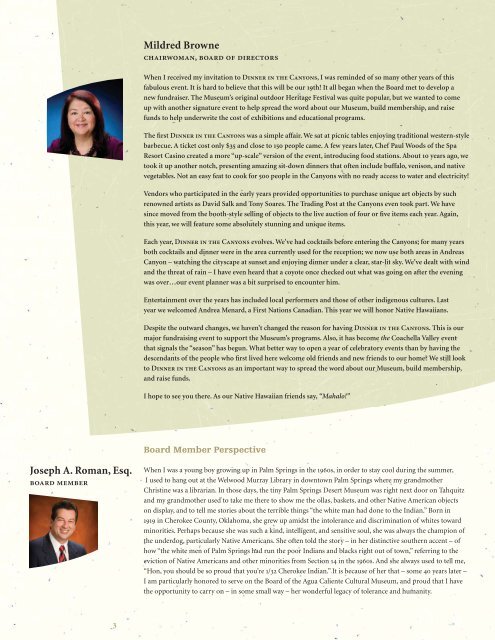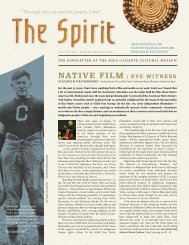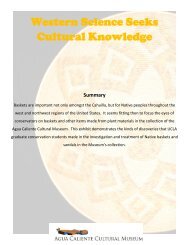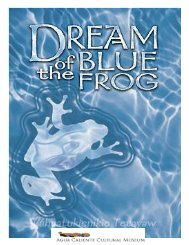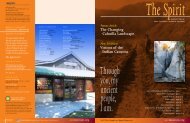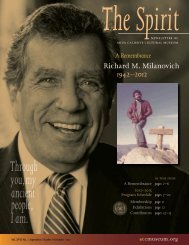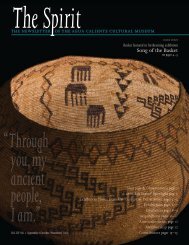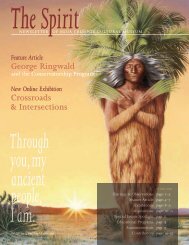accm newsletter2_20pg_FINAL.indd - Accarchives.org
accm newsletter2_20pg_FINAL.indd - Accarchives.org
accm newsletter2_20pg_FINAL.indd - Accarchives.org
- No tags were found...
Create successful ePaper yourself
Turn your PDF publications into a flip-book with our unique Google optimized e-Paper software.
Mildred Brownechairwoman, board of directorsWhen I received my invitation to Dinner in the Canyons, I was reminded of so many other years of thisfabulous event. It is hard to believe that this will be our 19th! It all began when the Board met to develop anew fundraiser. The Museum’s original outdoor Heritage Festival was quite popular, but we wanted to comeup with another signature event to help spread the word about our Museum, build membership, and raisefunds to help underwrite the cost of exhibitions and educational programs.The first Dinner in the Canyons was a simple affair. We sat at picnic tables enjoying traditional western-stylebarbecue. A ticket cost only $35 and close to 150 people came. A few years later, Chef Paul Woods of the SpaResort Casino created a more “up-scale” version of the event, introducing food stations. About 10 years ago, wetook it up another notch, presenting amazing sit-down dinners that often include buffalo, venison, and nativevegetables. Not an easy feat to cook for 500 people in the Canyons with no ready access to water and electricity!Vendors who participated in the early years provided opportunities to purchase unique art objects by suchrenowned artists as David Salk and Tony Soares. The Trading Post at the Canyons even took part. We havesince moved from the booth-style selling of objects to the live auction of four or five items each year. Again,this year, we will feature some absolutely stunning and unique items.Each year, Dinner in the Canyons evolves. We’ve had cocktails before entering the Canyons; for many yearsboth cocktails and dinner were in the area currently used for the reception; we now use both areas in AndreasCanyon – watching the cityscape at sunset and enjoying dinner under a clear, star-lit sky. We’ve dealt with windand the threat of rain – I have even heard that a coyote once checked out what was going on after the eveningwas over…our event planner was a bit surprised to encounter him.Entertainment over the years has included local performers and those of other indigenous cultures. Lastyear we welcomed Andrea Menard, a First Nations Canadian. This year we will honor Native Hawaiians.Despite the outward changes, we haven’t changed the reason for having Dinner in the Canyons. This is ourmajor fundraising event to support the Museum’s programs. Also, it has become the Coachella Valley eventthat signals the “season” has begun. What better way to open a year of celebratory events than by having thedescendants of the people who first lived here welcome old friends and new friends to our home? We still lookto Dinner in the Canyons as an important way to spread the word about our Museum, build membership,and raise funds.I hope to see you there. As our Native Hawaiian friends say, “Mahalo!”Board Member PerspectiveJoseph A. Roman, Esq.board memberWhen I was a young boy growing up in Palm Springs in the 1960s, in order to stay cool during the summer,I used to hang out at the Welwood Murray Library in downtown Palm Springs where my grandmotherChristine was a librarian. In those days, the tiny Palm Springs Desert Museum was right next door on Tahquitzand my grandmother used to take me there to show me the ollas, baskets, and other Native American objectson display, and to tell me stories about the terrible things “the white man had done to the Indian.” Born in1919 in Cherokee County, Oklahoma, she grew up amidst the intolerance and discrimination of whites towardminorities. Perhaps because she was such a kind, intelligent, and sensitive soul, she was always the champion ofthe underdog, particularly Native Americans. She often told the story – in her distinctive southern accent – ofhow “the white men of Palm Springs had run the poor Indians and blacks right out of town,” referring to theeviction of Native Americans and other minorities from Section 14 in the 1960s. And she always used to tell me,“Hon, you should be so proud that you’re 1/32 Cherokee Indian.” It is because of her that – some 40 years later –I am particularly honored to serve on the Board of the Agua Caliente Cultural Museum, and proud that I havethe opportunity to carry on – in some small way – her wonderful legacy of tolerance and humanity.3


